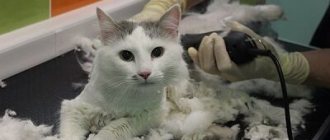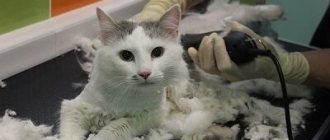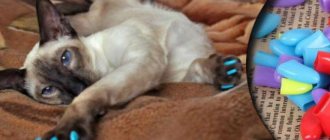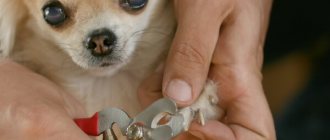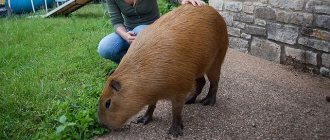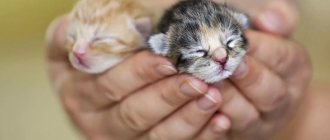Every cat lover knows firsthand what ties on furniture are. Cats love to sharpen their claws on everything they like: furniture, clothes, curtains, carpets, etc. They do this not “out of harm.” Sharpening claws is a natural need of an animal. Of course, you can simply trim your pet’s nails, but animals are not happy with this procedure. And the owners themselves do not always like this painstaking and dangerous task.
- 2 Benefits and harms of anti-scratch products for cats
- 3 How to choose anti-scratch products for cats of different ages
- 4 Rules for using anti-scratch pads
4.1 When not to cap cats’ claws
- 4.2 How to glue cat claw caps
- 6.1 Video: anti-scratch in action
When overlays are needed
Anti-scratch caps (second name) are oblong caps made of soft plastic or silicone. They follow the shape of the claw and are “settled” on top using special medical glue. It is hypoallergenic and suitable for most cats without causing any discomfort.
Although not all owners and veterinarians support the idea of wearing such attachments, there are several reasons when it is still worth purchasing them and teaching your pet to walk in them.
- Small children.
Kids love to play with cats, cuddle, pull by the tail, pinch and show love in other “non-standard” ways. Not all animals are able to tolerate bullying and react calmly to it. Some may use their claws as a defense and inadvertently injure the child's skin. In such cases, anti-scratches will be one hundred percent justified. - Protection of household items.
Not only sofa upholstery, wallpaper and door frames, but also curtains, carpets, children's toys, and clothes often suffer from tenacious cat claws. To protect interior and wardrobe items from damage (often irreversible), you will have to use overlays.
- Character traits.
It happens that cats cannot be re-educated or show aggression towards their owners, guests, children, etc. They can rush at imaginary offenders, scratch themselves, break free from their hands - behave nervously and inappropriately. Or hurt other domestic animals present on their territory. The use of caps will reduce the risk of injury and slightly pacify the cat's temper. - Household safety.
Here we are talking about possible harm to health. The claws contain microbes, and if there are deep scratches, they can enter the wound, causing inflammation. In the worst case, blood poisoning. People who have weak immunity, poor blood clotting, or a predisposition to various allergic reactions should beware of damage.
Reviews from owners and veterinarians
Sometimes cat owners devote so much time and effort to caring for their pet that it becomes difficult not to share their experience with others
There are many online forums devoted to topics about cats and cats. Cat breeders share their victories and disappointments, experiences and knowledge. And sometimes inexperienced pet owners just need advice. Few owners know about anti-scratches. Those who have already tried to use them are either satisfied with the device (and praise it) or disappointed (and criticize it). Some people who tried anti-scratch products got completely unexpected results.
I glued these to my cat, they are great. What’s funny is that I haven’t even run out of one box, but I stopped gluing them to him, I just continue to cut them, because he’s used to his nails not being scratched and has stopped even tearing up rugs. But I glued them to him from a young age. When you glue, make sure that the glue with the cap does not stick to the finger, otherwise the nail will grow and it will hurt the cat.
Forum user
https://m.woman.ru/home/animal/thread/4363561/https://m.woman.ru/home/animal/thread/4363561/
It often happens that after improper use unpleasant consequences occur. And the point here is not in the shape of the caps, or even in the quality of the glue. It’s just that every new item always evokes many different emotions. And here it’s up to you to decide whether to use it or not.
These anti-scratches are not needed, I was convinced from my own experience. I bought them for my cat, now I am suffering both myself and the cat. She took off all these caps, I didn’t re-sculpt them so as not to torture the animal, but one of her caps couldn’t be removed, and the nail festered. Today I wanted to take her to the vet, but Sunday is a day off, and in the evening I’m going on a business trip until Friday, how will my cat be here without me.
tory11, forum visitor
https://www.zoovet.ru/forum/?items=20&page=2&tem=307273&tid=18
Selection rules
There are many models of anti-scratch pads on the market, not only in different colors, but also in size categories. Conventionally, they are all divided into the following groups:
- XS (supermini)
- for kittens from 6 months. - S (mini)
- weight 2-4 kg. - M (medium)
- weight 4-7 kg. - L (large)
- weight 8 kg or more.
As for the price, the average cost of a set (40 pieces + glue + instructions) costs between 300-700 rubles. You can buy it at a pet store, veterinary clinic or specialized online markets.
When pads are not needed
It is not always necessary to use silicone attachments for cats. In some cases, they may be simply useless or even harm the animal. Anti-scratch guards cannot be worn by:
- Kittens.
The nail plate is formed until about six months, so it is recommended not to do anything with the claws during this period of time. It's best to focus on teaching kittens how to use a scratching post. - Elderly cats.
The older the age, the less active the animals become. They stop frolicking, running around the apartment, tearing up furniture and doing other dirty tricks. Therefore, there is no point in once again exposing their nervous system to stress and tormenting them with a new procedure. - Sick cats.
If for some reason the pet feels unwell or is in the acute phase of the disease, then it is advisable to wait until the pet has fully recovered from the “manicure”. This also applies to cases where there are some dermatological problems with the paws. - Street cats.
Unlike their domestic counterparts, who do not need to constantly keep their instinct of self-preservation in good shape, climb trees and get food on their own, wild animals with overlays simply will not survive. Their claws serve as a tool for protection and coordination.
Mr. Cat recommends: the opinion of veterinarians
Veterinarians believe that the procedure of putting on anti-scratch guards can cause stress for up to several weeks even in a calm animal. With attachments, the cat cannot fully wash itself, does not feel the surface on which it moves, all this causes discomfort. Doctors advise:
- Attach the caps only to healthy paws. If there are injuries, irritation, fungal or infectious lesions, the animal must first be treated.
- When the anti-scratch pads are already glued, you need to regularly inspect the paws for fungus or infection.
- Apply the pads carefully to prevent glue from getting on the skin, since as the claw grows, painful cracks may form on the skin, which are favorable for the development of infection.
- If an allergy to glue manifests itself in the form of irritation or swelling, you must immediately contact a veterinarian and remove the anti-scratch protectors.
Useful tips
To make it comfortable for your cat to wear the caps, veterinarians advise adhering to a number of requirements:
- Before the procedure, it is necessary to trim the claws approximately 1 mm from the edge. So as not to touch the blood vessels and cause pain to the animal. On the cut edges, the linings fit more tightly and, accordingly, fall off less often.
- Do not neglect the size chart and select a set based on the dimensions of the cat. The cap should not touch the skin, but should completely cover the nail. If there is an error with the size and it is not possible to exchange the pads, then they can be carefully trimmed at the base.
- Typically, anti-scratch guards are only applied to the claws of the front paws, since the cat does not sharpen the hind paws. She gnaws them on her own without the involvement of external “helpers.” Moreover, it is not necessary to cover all five claws; the side one can be excluded - it is not often used in life, plus, it does not peel off in time. As an experiment, you can try first sticking a cap on it and then leaving it free.
- Silicone disappears as the upper stratum corneum of the nail grows. Natural “reset” occurs approximately every 2 months, so there is no need to specially peel off the pads. On the contrary, they may fall off on their own if they were chosen in the wrong size, or if the cat deliberately chewed them off with his teeth.
Regularly checking your cat's paws can prevent many problems. For example, inflammation due to improper use of anti-scratch products or allergies if the skin reacts to silicone or glue.
How often should you change cat claw attachments?
It is possible that from time to time the cat will remove the anti-scratch protection itself.
If your four-legged friend sometimes tears off (loses) the pads, they can be re-glued. You cannot use the old cap; you will need to glue a new cover each time. Moreover, you don’t have to wait until all the anti-scratch pads fall off; you can add them one at a time.
Some who have never tried it before buy several sets of anti-scratch products in different colors. For example, in bags of 10 or 20 pieces. Using the entire set at one time, for “correction” you will have to open another bag. The next time you completely replace all the pads, one cap may not be enough. Therefore, it is more convenient to buy anti-scratch pads with a large number of pads of the same color, for example, 40 or 60 pieces. Or buy several packages of different colors and mix. Such methods are suitable for those people who already have an adult cat (the size of the claw will not change).
Of course, anti-scratch pads do not stick forever. The natural claw must sometimes be released, but tearing off a tightly fitting pad is painful for the animal. Therefore, you can wait until your pet's claw is updated. As the claw tissue is renewed, old cells will die off. Thus, the cap will easily come off along with the dead layer of the claw. This can happen about a month after gluing. In younger cats, this period may be shorter (about 3 weeks), but this is rare. A properly glued cap can last up to 8 weeks.
How to glue overlays: instructions
The procedure involves not only mechanical actions, but also a corresponding psychological component. Do not forget that for an animal any manifestation of violence against its freedom is a great stress.
- Sit the cat on your lap, stroke it, talk in a calm voice, affectionately, without pressure.
- Take one paw and press on the pad until the nail appears. Try on the cap to see if it fits properly. If necessary, cut to the required length on the side of the hole through which it is inserted.
- Treat the inside of the lining with the glue from the kit. The silicone surface should be covered no more than 1/3.
- Put on the nozzle using a sliding motion, press on both sides for about 3-5 seconds until the glue sets.
- After 10 minutes, check how well the anti-scratches are fixed and, if necessary, make corrections.
- Praise the cat for its patience and treat it with a tasty treat.
Tips for use
When used correctly, one set of cat nail caps will last for two months. And the process of putting them on does not cause any big problems for the owners.
- Wipe the caps before gluing with a cotton pad soaked in an acetone-free disinfectant. This will clear the dirt and the pads will stick better.
- Use a nail file to smooth the surface of your cat's claw to make it rougher. The caps will stick faster.
- Glue stuck to your fingers can be easily cleaned with nail polish remover.
- Anti-scratch guards are usually placed on the cat's front paws. For more effective protection against scratching, caps can also be glued to the hind legs.
Basic questions when purchasing
When faced with the choice of whether to buy such devices for your pets or get by with the classic “sharpening” of claws/surgery, a number of related questions arise. For example:
- What happens if an animal swallows the bait? Nothing bad will happen. The caps are made of non-toxic material, have a smooth surface and, when ingested, can easily pass through the entire gastrointestinal tract and exit naturally.
- How quickly will the cat get used to the new condition? Everything is individual. Usually the adaptation process lasts 2-5 days, during which she may get nervous and try to chew or remove the interfering accessory, but then she gets used to it and resigns herself.
- Will the habit of sharpening your claws go away? No, the instinct remains, the animal will still release its claws, but it simply will not be able to harm furniture, walls, wallpaper or a person.
- Which manufacturer is better? The best brands that have proven themselves in this area are: Soft Paws Nail Caps For Cats (USA), Cliny, Crazy Liberty (Russia), Barbos (Russia).
Anti-scratch pads for cat paws
What are anti-scratch products for cats?
These are soft silicone caps that are fixed to the claws using a special non-toxic glue.
You need to fill the cap with special glue very carefully.
The anti-scratch pads are glued quite easily: the cap (see photo) is filled with glue and put on the claw.
The glue dries almost instantly.
The procedure is absolutely painless and does not harm the animal.
Sometimes in the first two or three days the cat may become angry and try to chew out the silicone caps, but this quickly passes.
And even if she manages to chew off a couple of pads, they are easy to replace.
